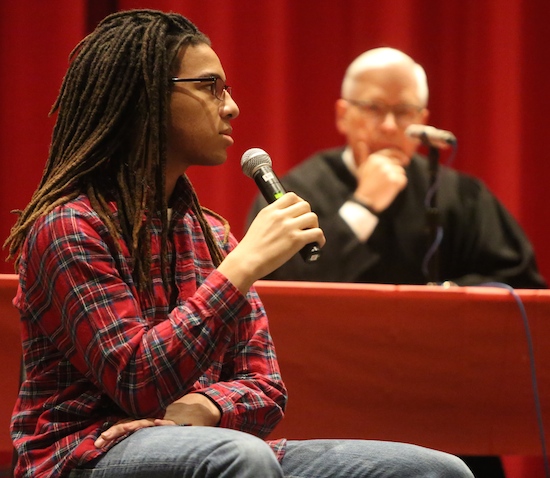
Dave Hrbacek/The Catholic Spirit
In a mock trial that simulated the legal system in Texas, student jurors at Benilde-St. Margaret’s High School in St. Louis Park, Minnesota, chose overwhelmingly to spare Jesus Christ from the death penalty.
“It was a pretty good day for Jesus, overall,” prosecuting attorney Mark Osler concluded at the end of “Jesus on Death Row: The Trial of Jesus and American Capital Punishment” Feb. 25.
Osler, author of a book of the same title, is a law professor at the University of St. Thomas in Minneapolis and has conducted similar simulated trials in 11 states, but never before at a high school.
Just as in a regular trial, members of the junior class at the suburban Minneapolis school who acted as jurors received instructions in the law from a judge — in this case an actual judge, Minnesota Supreme Court Justice David Lillehaug.
They heard opening arguments, listened as “witnesses” testified and were cross-examined, and heard attorneys’ closing arguments, with Osler as the prosecutor and Hank Shea, a veteran attorney who also teaches at St. Thomas Law School, as defense counsel. BSM alum Annie Rondoni-Tavernier also served as counsel for the defense.
Staging the program at BSM was the idea of religion teacher Claire Shea, Hank’s daughter.
“We study morality in our religion classes,” she said, “so it’s so important to get situations in front of students where they have to apply morality.
“Students are going to face moral questions in real life, tough questions, so this is a good model to get them to deal with those kinds of questions.”
Osler explained that, for the purposes of the program, the first part of the Texas death penalty law was being skipped; in that portion of the proceedings, Jesus was found guilty of blasphemy, a capital offense, and of aggravating factors.
The second part of the law in Texas — the state with by far the highest number of executions both within the past five year and over the last 40 — requires juries to determine, first, if there is a probability that, if not executed, the defendant would be a continuing threat to society, and second, if the death sentence is still warranted despite any mitigating circumstances. Minnesota does not have the death penalty.
Passages from the gospels were used to elicit testimony about Jesus’ extraordinary power (walking on water), his ability to draw masses of people and for violence to be committed on his behalf (when Peter cut off the ear of the high priest’s servant).
Jesus’ words were turned against him, and testimony elicited to show that him a threat to the economy and society by calling disciples away from their jobs and families.
Questioned by the defense, witnesses — Simon Peter and his wife, a centurion, and the woman Jesus saved from stoning — told of Jesus’ history of love, healing, forgiveness and his respect for Roman law (“Render unto Caesar what is Caesar’s”).
Divided into traditional jury groups of 12, students deliberated then were asked for their verdicts.
Nearly two-thirds of the 16 groups dismissed the death penalty for Jesus outright, deciding he did not pose a continuing threat to society. Most other “juries” said he did pose a continuing threat, but they either decided there were mitigating circumstances that precluded Jesus’ execution or the jurors failed to reach the mandatory unanimous decision to apply the death penalty.
Of the 16, only one group of student jurors voted that the death penalty was warranted for Jesus.
Benilde-St. Margaret’s principal Susan Skinner called the trial a wonderful educational opportunity to approach faith from a different perspective. “It’s an opportunity for our students to think critically and make the connection between the intellectual and the heart of faith,” she said.
From a faith formation perspective, Claire Shea said it is sometimes easy to forget Jesus was a person with human emotions.
“As a religion teacher, when we talk about the need to know Jesus, we can more easily find that relationship and that connection when we see him as human,” she said. “I hope to inspire that more.”



